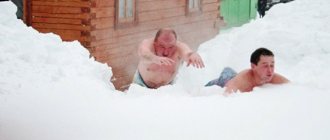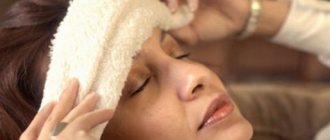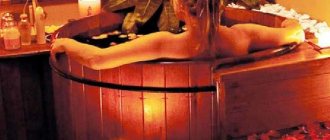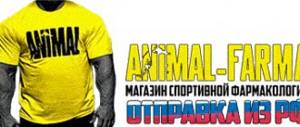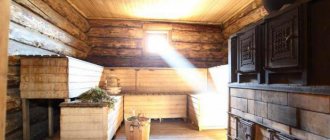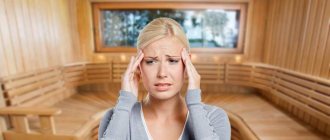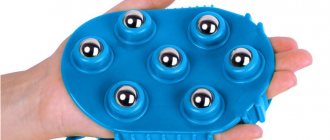A Caesarean section during the day of a pregnant woman is sometimes the only way to save the child’s life. Such an operation while caring for a baby is not fully perceived. And the woman is obliged to take precautions in the postoperative period. So, a bath after a caesarean section is prohibited - the postoperative period must be waited out. Here you should follow certain recommendations for further visits to the bathhouse or sauna. Other recommendations for washing in a sauna will be discussed in detail in the article.
Features of visiting the steam room
If, after examinations, the doctor gives the go-ahead for bathing procedures, the woman should follow some recommendations:
- You can stay in the steam room for 5 minutes. In this case, whipping with a broom is prohibited.
- When your visit to the steam room is over, you need to take a cooling shower. This is a mandatory procedure. A contrast shower helps to constrict blood vessels, which reduces the risk of bleeding.
- Swimming in the pool is strictly prohibited. Water procedures put increased pressure on the seams. This will lead to the development of inflammatory processes.
Women you know can frighten you with stories and myths about visiting a bathhouse after childbirth. Myths:
- Bleeding can only begin when the stitches come apart. This is a misconception. Blood can only flow due to enlargement of blood vessels. They take a long time to recover after surgery and can cause bleeding.
- Milk burnout from visiting the steam room. This statement has never found scientific substantiation, which is why it is considered erroneous. Women say that they notice an improvement in lactation after visiting the steam room.
You cannot trust the opinions of outsiders regarding the issue of visiting a bathhouse after a caesarean section. Experienced doctors should monitor the woman’s condition.
Shower in the bath
bath after caesarean when possible
So, my baby is a little over a month old. Throughout my pregnancy, I searched the Internet for dowry lists and compiled my own. And yet it turned out to be not entirely optimal in the end. I didn’t use some things at all, but I had to buy some more in the first month! And only now I can write what was actually useful to me at first.
Large things:
— a crib, a mattress, a blanket, two sets of bed linen, a bumper, a pair of waterproof diapers on the mattress under the sheet (I often use the crib as a place where the baby can be left alone for a short time in safety. He sleeps at night in our big bed , because after a cesarean it was difficult for me to get up and shift)
— a stroller (I only used it a few times in the first month, my baby almost always eats and sleeps, wakes up when being shifted and dressed, so at first we almost didn’t go outside)
- bathtub for bathing (we don’t have a large bathtub in the house, only a shower, if there is a bathtub, then a small children’s room is not needed)
- humidifier
- a device for measuring temperature and humidity in a room
Hygiene:
- bepanthen cream
- disposable diapers for newborns (three small packs of different brands to see which ones are best)
— wet wipes for newborns with a plastic lid on top to make it easy to take with one hand)
— paper tissues in a box (it’s also very convenient to take it out with one hand, for example, if the baby burps while I’m changing a diaper)
- universal soap-shampoo for newborns (both for the butt and the head)
— cotton swabs for children with a limiter (so as not to accidentally get inside the ear if the baby jerks his head)
- cotton pads (to wash your face)
- nail file and scissors with rounded edges for nails
— comb-brush with natural bristles (my baby was born with hair straight away)
— disposable diapers (I don’t have a changing table, I put a diaper on the lunch table, if I need to eat, I put it away, if it’s dirty, I throw it away! And no additional washing)
- small cotton towels 30x30 cm. IKEA sells 10 pieces for 200 rubles. 4-5 packs are necessary (this is to blot your butt after washing and put it on your shoulder so that it doesn’t spit up on my clothes and on the bed during feeding, again, so that regurgitation doesn’t get on our sheet)
- a piece of muslin (I have eight of them, so put it somewhere and wipe it off)
— a couple of regular bath towels (I somehow didn’t like the corner one)
- a thermometer to measure the water temperature before swimming
Diaper powders and creams are not needed yet. After each wash, I blot all the folds dry and, if possible, do gymnastics so that the skin can breathe without a diaper)
Feeding:
I breastfeed, but sometimes I need to go to the hospital or to the store, so:
- breast pump
— a couple of bottles with pacifier 0+
— a set of milk containers in which you can freeze milk
- packages for sterilization in the microwave oven
The baby does not take pacifiers because he is breastfed. Dad heats up the milk that I leave out simply under running water.
Cloth.
This is the most interesting thing. PDR beginning of April. The weather is completely unclear, it could be -5 or +10. And growth. We all seem to be not very tall, but the baby was born immediately 54 cm with a leg of 8 cm! Therefore, everything small was immediately small. And now I’m writing here not what didn’t fit, but what was really needed.
And yet, I am in favor of car seats from birth upon discharge from the hospital, so all sorts of envelopes are out of the question. Also, only my husband took us from the maternity hospital. I didn’t want any ceremonial discharge after the cesarean, and in general in the first month there is no time for guests, so all sorts of discharge outfits are also automatically eliminated)
- demi-season overalls (it’s better to ask your husband to buy it after the baby is born, otherwise you can make a mistake with the size, as I did, and it’s easier to guess with the weather. In the maternity hospital it’s 3-7 days anyway, there will be time)
- a pair of thin hats (my baby doesn’t like hats with ties, so I chose those that simply fit over the ears, like those worn by newborns in American films)
— warm knitted hat
— three cotton slip-on overalls with button fastening on the side so as not to touch the clothespin on the navel and with sewn-in scratches. (individual scratches immediately fly off as soon as the baby starts to move) after the baby is born, the size will be clear and you need to buy 4-5 more overalls. Total 7-8 overalls. That's it, no more clothes.
- three pairs of socks, newborns often have cold feet (the size is easier here, the socks stretch)
That's all I really needed.
When can you start going to the steam room?
When a woman is sent home after childbirth, she can perform gentle water procedures using a warm shower. You can lie in the bathroom or visit the steam room no earlier than 45 days after surgery. Since the recovery process is individual, a woman needs to consult with her doctor in advance and take into account:
- general state;
- healing time of sutures;
- pelvic pathologies, if any;
- presence of complications.
If the general condition has not returned to normal 2 months after surgery, the ban on visiting the steam room may last up to three months.
How to steam properly after childbirth
After childbirth, you need to steam with caution, so at first you should follow the rules:
- enter the steam room for no more than 5 minutes;
- the body must remain dry;
- rest for 10 minutes in the dressing room after each visit, take a cool (not cold) shower;
- immersion in cold water is prohibited in the first six months;
- the number of visits to the steam room should not exceed 4-6 times;
- you need to drink herbal tea, fruit juice, and water in sufficient quantities to prevent dehydration.
It is important for women that when visiting a bathhouse or sauna there is a person nearby who, if necessary, can provide first aid in case of fainting, since even those accustomed to temperature changes can experience unusual reactions.
Benefit
Beneficial features:
- the wound healing process is accelerated;
- the psychological state of postpartum depression improves;
- the number of red blood cells in the blood increases.
Because of this, doctors strongly advise visiting the bathhouse after a caesarean section, when the body has recovered.
Sauna during lactation
Many are sure that the bath remains prohibited during the entire period of breastfeeding. However, this is not at all true. A nursing mother can safely visit the bathhouse. This cannot in any way affect the taste and quantity of milk.
Burning milk in a sauna is a myth that has no scientific basis. This popular definition describes heat in the chest due to stagnation of milk. This phenomenon can occur only when feeding is stopped, but not from the temperature of the bathhouse.
Read also:
Planning a second child: how long before you can get pregnant after a cesarean section
Contraindications
Bathing procedures are prohibited for a woman after surgery if she experiences complications:
- anemia;
- acute inflammatory processes;
- increased body temperature;
- disruption of the cardiovascular system;
- diseases associated with hormonal levels.
In addition to contraindications for women who have had a caesarean section, there are a number of general prohibitions on visiting the bathhouse:
- asthma;
- hypertonic disease;
- renal failure;
- diabetes;
- presence of cancer.
Types of injuries and indications for bath procedures
A fracture is an injury that involves deformation of a bone. There are 2 types of fractures. If the fracture is accompanied by an open wound, then it is called open. When there are no external injuries, this is a closed fracture. With open fractures, not only the bone is damaged, but also the skin, muscle tissue, and blood vessels.
The most severe and dangerous fractures are displaced injuries, the process of treatment and recovery from which will take a long time. When bones are displaced, there is a risk of developing complications:
- bleeding (open and closed);
- decreased sensitivity;
- partial paralysis;
- disruption of the innervation of the limbs (connection of nerve endings with the central nervous system).
The bathhouse is indispensable in the treatment of musculoskeletal injuries. Fractures of the limbs are not the most dangerous cases; for such injuries, bath procedures are useful. A fracture associated with a dislocated joint complicates the situation, and the recovery period will be longer. Also, the duration of treatment differs in the case of a fracture of the sacrum or (this can occur when the pelvic bones are damaged).
A common type of injury is. In this case, blood and foam are released from the victim’s respiratory tract, suffocation occurs, and there is a danger of lung damage. And the most dangerous are spinal injuries - after this a person can suffer complete or partial paralysis.
For all types of fractures, bath procedures are indicated. After all, even with the most complex injuries, a bath promotes the rapid formation of callus at the site of fractures and cracks, and hot air has a healing effect when stretching injured muscles, tendons and ligaments.
Recovery is accelerated:
- impaired blood supply to muscle tissue causes hypoxia, and intense heating of the body stimulates blood flow;
- massage treatments using a broom and inhaling hot air improve regenerative processes;
- due to blood flow to the affected area, pain is reduced, restoration of cartilage and bone tissue is accelerated;
- endorphins (hormones of happiness) are released;
- tone and mood increase.
Principles of visiting the steam room
If bath procedures are carried out incorrectly, the body can overheat, which will lead to serious complications. Rules for visiting the bathhouse:
- You cannot visit the steam room more than 5 times a day.
- The duration of bath procedures is 5 minutes.
- After visiting the steam room, the body should be dry.
- It is strictly forbidden to be alone in the bathhouse. A woman may become ill and require urgent help.
There are often situations when a woman cannot give birth naturally. In this case, surgery is performed. After the operation, restrictions are imposed on the usual way of life, among which is visiting the bathhouse. In order for bath procedures to be safe for the body, it is necessary to follow some rules and take into account the general condition.
What do doctors think?
All doctors have their own opinion and their own methods of recovery after childbirth, which they offer to mothers in the postoperative period. Many doctors completely prohibit patients from overheating and hypothermia, since these body conditions can negatively affect lactation, as well as the general health of the woman. However, it should also be taken into account that there are specialists who hold a different point of view, especially when they observe rapid recovery after cesarean section and normal healing of the suture.
But even in this case - when obtaining permission from the gynecologist - it is recommended to follow the following simple rules:
- The body must remain dry when entering the steam room.
- During lactation, someone else should be in the sauna as support. There should be a person nearby who can help leave the steam room if the woman feels unwell.
- If dizziness begins, you must have a wet towel with you.
- The body should not be allowed to overheat, so one trip to the sauna or steam bath should not last longer than five minutes.
- Experts recommend visiting the steam room no more than five times in one day, taking into account the time indicated above.

